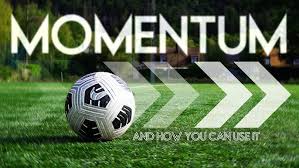
Momentum is one of football’s most discussed and debated concepts. Fans, commentators, and players all feel it: a key goal, a spectacular save, a crucial refereeing decision, these moments can energize one team while unsettling the other. Momentum is often described as a sudden shift in control, where one side dominates possession, creates chances, and looks likely to score again. It often shows itself most visibly when a team scores multiple goals in a short period, for example, two goals in two minutes can make the trailing side appear overwhelmed and disorganized and the scoring side is seen as riding on momentum. Commentators frequently frame the story of a match around these surges, saying things like “the momentum has shifted” or “they need to weather the storm,” turning an emotional, short-term phenomenon into a compelling narrative for viewers.
For players, momentum is tangible. A team can feel unstoppable after a breakthrough goal, while the opposing side may temporarily lose focus. Managers and clubs are keenly aware of these swings, preparing tactical strategies to stabilize their own team or disrupt the opponent’s confidence. While momentum is real in its psychological and emotional impact, it does not always translate directly into measurable advantage on the pitch. This distinction between perceived momentum and statistical reality is central to understanding how matches unfold.
Momentum is most immediately experienced at the player level. A goal can spark a rush of confidence, improved movement, and sharper decision-making. Conversely, conceding can induce hesitation, overthinking, or panic. Cristiano Ronaldo famously described this feeling in striking terms saying in 2010 “Goals are like ketchup, when it comes out, it all comes out at once.” For strikers and attacking players, a single goal can unlock a period of heightened form, while teammates can feed off the increased energy and belief.
Crowds magnify these effects. Supporters’ cheers, chants, and collective energy can pressure the opposition, leading to mistakes that appear like a momentum-driven advantage. This surge often seems decisive, even if it is short-lived.
From the club’s perspective, managing these shifts is crucial. Coaches use tactical breaks, substitutions, and in-game instructions to stabilize players’ focus and prevent lapses. Training often includes simulated scenarios to prepare players for emotional swings, both the euphoria of scoring and the shock of conceding. Momentum, then, exists as a genuine psychological phenomenon: it shapes individual confidence, influences team behavior, and requires active management by clubs to maximize its benefits or mitigate its risks.
While momentum feels real to players and fans, statistical analysis shows that its effects rarely last long or predict subsequent events. One counterintuitive finding is the post-goal dip: teams are often most vulnerable immediately after scoring. The euphoria of a goal can make players overconfident, overcommit in attack, or lose focus defensively. Strikers may push higher, defenders may be caught out of position, and opponents can exploit these brief lapses.
Data supports this. Studies tracking Expected Goals (xG) and dangerous chances show that goals rarely trigger long-lasting waves of dominance. Most “momentum bursts” last five to ten minutes at most before the game returns to its prior balance. From a player perspective, the adrenaline spike is real, but it doesn’t guarantee continued scoring opportunities.
Clubs anticipate these patterns. Coaches prepare teams for post-goal shifts by instructing players to maintain shape, remain disciplined, and not overcommit. Tactical drills and defensive protocols are designed to prevent euphoria from turning into vulnerability. Momentum may influence individual decision-making, but at the organizational level, its impact is often short-lived and manageable.
Despite the statistical reality, momentum remains a popular concept because it simplifies complex football dynamics. Fans and commentators remember moments when a goal seemed to trigger a scoring spree, while hundreds of quieter moments are forgotten, a classic confirmation bias.
Momentum also serves as a storytelling tool. Explaining a game as a “shift in energy” is more compelling than describing positional adjustments, fatigue, or tactical vulnerabilities. For example, one team’s “surge” may actually be the opposition tiring physically or stretching defensively to chase the game. Similarly, a sudden scoring run may coincide with opponent mistakes rather than a true, unstoppable wave.
At the club level, this perception matters too. Managers are aware that fans, media, and even board members expect teams to capitalize on apparent momentum. Training and match preparation often include psychological coaching to help players recognize these emotional surges without overreacting. In this sense, momentum exists as both a real short-term psychological boost and a narrative shortcut, shaping perception more than measurable tactical advantage.
Momentum is more than just a narrative convenience, it has real psychological and emotional effects on players and teams. A goal can boost confidence, sharpen decision-making, and create a temporary period where players feel unusually effective. These surges can spark a series of scoring opportunities and elevate team performance in the short term.
From a club perspective, momentum is something coaches both recognize and manage. Tactical adjustments, substitutions, and structured instructions are used to harness positive surges or stabilize the team after conceding, ensuring that short-term emotional boosts do not create lasting vulnerabilities.
While momentum may not reliably predict long-term outcomes, its influence on player confidence, team cohesion, and match rhythm is undeniable. It can shape how games unfold, how fans experience the match, and even how clubs approach in-game management. The key is understanding it: momentum is powerful yet fleeting, impactful yet controllable. Football is as much about managing emotion and belief as it is about tactics, and in that sense, momentum remains a genuine and influential part of the game.








